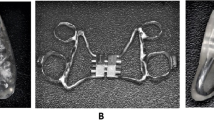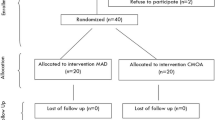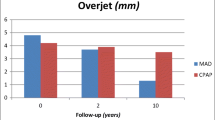Abstract
Purpose
In view of the positive outcome of orthodontic treatment using rapid maxillary expansion (RME) on sleep-disordered breathing, we generated data on RME in children with obstructive sleep apnea (OSA) by evaluating objective and subjective data over a 36-month follow-up period, to determine whether RME is effective in the long-term treatment of OSA. We selected all patients with dental malocclusions and OSA syndrome (OSAS) confirmed by polysomnography.
Methods
Ten of the 14 children who completed the 12-month therapeutic trial using RME were enrolled in our follow-up study. The study was performed 24 months after the end of the RME orthodontic treatment. We enrolled all children presented with deep, retrusive or crossbite at the orthodontic evaluation. All subjects underwent an overnight polysomnography at the baseline, after 1 year of treatment and 24 months after the end of the orthodontic treatment. The children's mean age was 6.6 ± 2.1 years at entry and 9.7 ± 1.6 years at the end of follow-up.
Results
After treatment, the apnea hypopnoea index (AHI) decreased and the clinical symptoms had resolved by the end of the treatment period. Twenty-four months after the end of the treatment, no significant changes in the AHI or in other variables were observed.
Conclusions
RME may be a useful approach in children with malocclusion and OSAS, as the effects of such treatment were found to persist 24 months after the end of treatment.
Similar content being viewed by others
References
Guilleminault C, Partinen M, Praud JP, Quera-Salva MA, Powell N, Riley R (1989) Morphometric facial changes and obstructive sleep apnea in adolescents. J Pediatr 114:997–999
Guilleminault C, Li KK, Khramtsov A, Pelayo R, Martinez S (2004) Sleep disordered breathing: surgical outcomes in prepubertal children. Laryngoscope 114:132–137
Tasker C, Crosby JH, Stradling JR (2002) Evidence for persistence of upper airway narrowing during sleep, 12 years after adenotonsillectomy. Arch Dis Child 86:34–37
Mitchell RB, Kelly J (2004) Outcome of adenotonsillectomy for severe obstructive sleep apnea in children. Int J Pediatr Otorhinolaryngol 68:1375–1379
Souki BQ, Pimenta GB, Souki MQ, Franco LP, Becker HM, Pinto JA (2009) Prevalence of malocclusion among mouth breathing children: do expectations meet reality? Int J Pediatr Otorhinolaryngol 73:767–773
Pirelli P, Saponara M, Guilleminault C (2004) Rapid maxillary expansion in children with obstructive sleep apnea syndrome. Sleep 27:761–766
Villa MP, Malagola C, Pagani J, Montesano M, Rizzoli A, Guilleminault C, Ronchetti R (2007) Rapid maxillary expansion in children with obstructive sleep apnea syndrome: 12 months follow-up. Sleep Med 8:128–134
Cistulli PA, Palmisano RG, Poole MD (1998) Treatment of obstructive sleep apnea syndrome by rapid maxillary expansion. Sleep 21:831–835
Kiliç N, Oktay H (2008) Effects of rapid maxillary expansion on nasal breathing and some naso-respiratory and breathing problems in growing children: a literature review. Int J Pediatr Otorhinolaryngol 72:1595–1601
De Felippe NL, Bhushan N, Da Silveira AC, Viana G, Smith B (2009) Long-term effects of orthodontic therapy on the maxillary dental arch and nasal cavity. Am J Orthod Dentofacial Orthoped 136:490.e1–490.e8
Monini S, Malagola C, Villa MP, Tripodi C, Tarentini S, Malagnino I, Marrone V, Lazzarino AI, Barbara M (2009) Rapid maxillary expansion for the treatment of nasal obstruction in children younger than 12 years. Arch Otolaryngol Head Neck Surg 135:22–27
Zucconi M, Caprioglio A, Calori G, Ferini-Strambi L, Oldani A, Castronovo C, Smirne S (1999) Craniofacial modifications in children with habitual snoring and obstructive sleep apnoea: a case–control study. Eur Respir J 13:411–417
Guilleminault C, Huang YS, Glamann C, Li K, Chan A (2007) Adenotonsillectomy and obstructive sleep apnea in children: a prospective survey. Otolaryngol Head Neck Surg 136:169–175
Ancoli-Israel S, Chesson A, Quan SF, for the American Academy of Sleep Medicine (2007) The AASM manual for the scoring of sleep and associated events: rules, terminology and technical specifications. American Academy of Sleep Medicine, Westchester
Greenfeld M, Tauman R, DeRowe A, Sivan Y (2003) Obstructive sleep apnea syndrome due to adenotonsillar hypertrophy in infants. Int J Pediatr Otorhinolaryngol 67:1055–1060
Friedman M, Ibrahim H, Joseph NJ (2004) Staging of obstructive sleep apnea/hypopnea syndrome: a guide to appropriate treatment. Laryngoscope 114:454–459
Ilizarov GA (1988) The principles of the Ilizarov method. Bull Hosp Joint Dis Orthop Inst 48:1–11
Brouillette R, Hanson D, David R, Klemka L, Szatkowski A, Fernbach S, Hunt C (1984) A diagnostic approach to suspected obstructive sleep apnea in children. J Pediatr 105:10–14
Rechtschaffen A, Kales A. Springer A manual of standardized terminology, techniques and scoring system for sleep stage of human subjects. Los Angeles: Brain Information Service/Brain Research Institute, University of California; 1968
Villa MP, Bernkopf E, Pagani J, Broia V, Montesano M, Ronchetti R (2002) Randomized controlled study of an oral jaw-positioning appliance for the treatment of obstructive sleep apnea in children with malocclusion. Am J Respir Crit Care Med 165:123–127
Zhao Y, Nguyen M, Gohl E, Mah JK, Sameshima G, Enciso R (2010) Oropharyngeal airway changes after rapid palatal expansion evaluated with cone-beam computed tomography. Am J Orthod Dentofacial Orthoped 137:S71–S78
Miano S, Rizzoli A, Evangelisti M, Bruni O, Ferri R, Pagani J, Villa MP (2009) NREM sleep instability changes following rapid maxillary expansion in children with obstructive apnea sleep syndrome. Sleep Med 10:471–478
Chrcanovic BR, Custódio AL (2009) Orthodontic or surgically assisted rapid maxillary expansion. Oral Maxillofac Surg 13:123–137
Conflict of interest
The authors declare that they have no conflict of interest.
Author information
Authors and Affiliations
Corresponding author
Rights and permissions
About this article
Cite this article
Villa, M.P., Rizzoli, A., Miano, S. et al. Efficacy of rapid maxillary expansion in children with obstructive sleep apnea syndrome: 36 months of follow-up. Sleep Breath 15, 179–184 (2011). https://doi.org/10.1007/s11325-011-0505-1
Received:
Revised:
Accepted:
Published:
Issue Date:
DOI: https://doi.org/10.1007/s11325-011-0505-1




